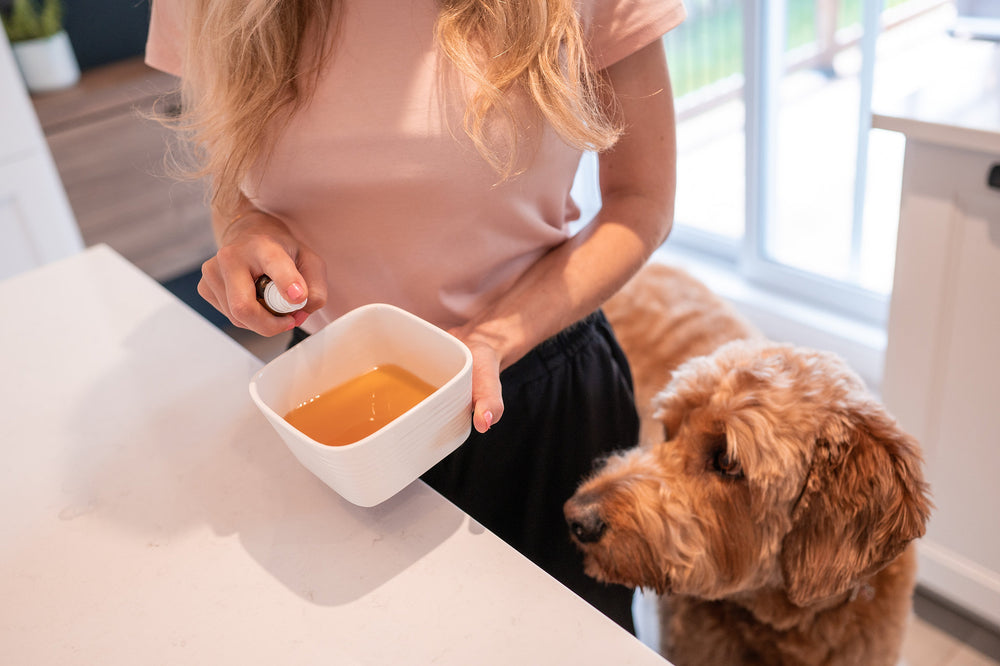Vet-Approved Guide: Top 10 Dog Training Tips for a Happy, Well-Behaved Companion
List of Contents
A well-trained dog adds joy, structure, and harmony to your home. Whether you're raising a new puppy or guiding an adult dog, training is a vital part of responsible pet parenting.
Effective dog training builds essential skills, encourages good behavior, and strengthens the bond between you and your pet. It also promotes safety, prevents boredom, and supports a happy, well-adjusted companion.
This guide shares the top 10 expert-backed dog training tips to help you achieve lasting results. Make your training journey more effective, rewarding, and enjoyable for both you and your dog.
10 Proven Dog Training Tips for a Well-Behaved Dog
Ready to start effective dog training? These 10 expert-backed tips will help you improve your dog’s behavior, strengthen communication, and build a lasting, positive bond with your canine companion.
Tip #1: Embrace positive reinforcement

Successful dog training starts with positive reinforcement. By consistently rewarding good behaviors, like sitting or responding to a recall, you encourage learning, build a strong bond, and avoid the need for corrective punishment.
Effective rewards are anything your dog truly enjoys, like small treats, a favorite toy, or enthusiastic praise. Choosing the right reward keeps your dog motivated and reinforces positive behaviors during training.
Proven to be highly effective, positive reinforcement motivates your dog to learn and try new behaviors with enthusiasm. It also deepens your bond, creating a more enjoyable and cooperative training experience.
Tip #2: Ensure unwavering consistency
Consistency is crucial for effective dog training, helping your dog understand and retain new behaviors. Using the same cues, rules, and routines reinforces learning and builds reliable habits over time.
Using the same words and tone for each command helps your dog understand what’s expected. Consistency across all household members is essential to avoid confusion and reinforce effective training.
Tip #3: Keep training sessions short and frequent
Frequent, short training sessions are ideal, especially for puppies, since they align with your dog’s attention span and reduce frustration. This approach keeps training productive, enjoyable, and easier to maintain over time.
Begin with a few repetitions and gradually extend session length as your dog’s attention span improves, aiming for 15–20 minutes. Several brief sessions throughout the day are more effective than one extended session.
Tip #4: Cultivate patience and maintain a positive attitude

Patience is essential in dog training, as every dog learns at their own pace. Staying calm and positive helps your dog feel secure and focused. Frustration only hinders progress and damages trust.
Keep training enjoyable and upbeat to motivate your dog and build a positive association with learning. End each session on a high note by practicing a well-known command that your dog can succeed with.
Tip #5: Use high-value and varied rewards
Identify what truly motivates your dog, whether it's treats, toys, or praise, and use those rewards to reinforce desired behaviors. For food-driven dogs, small, soft treats that are quick to eat work best during training.
Some dogs respond better to toys or affection than treats, so it’s important to match rewards to their preferences. Varying rewards keep training fun, prevent boredom, and maintain your dog’s motivation and focus.
Tip #6: Practice in diverse environments
Start training in a quiet, low-distraction space to help your dog focus and learn new behaviors. A calm environment sets the foundation for success before introducing more challenging settings.
Once your dog responds reliably at home, gradually practice in more distracting environments like your yard or a park. This process, called “proofing,” ensures your dog obeys commands in any setting.
Additionally, early socialization is crucial for your dog’s behavioral development and long-term well-being. Introducing them to new people, pets, and environments at a young age builds confidence and reduces fear or aggression. Well-socialized dogs are more adaptable, friendly, and easier to train.
Tip #7: Integrate training into daily routines

Integrating training into everyday routines reinforces good behavior and builds consistency. Ask your dog to "sit" before meals, walks, or playtime to turn daily moments into valuable learning opportunities.
Make it a habit to reward your dog for good behavior, even when it’s not prompted by a command. Recognizing and reinforcing these moments helps your dog develop positive habits on their own.
Tip #8: Understand your dog’s unique nature
Recognize that puppies are still developing both physically and mentally, and shouldn’t be held to adult expectations. Tailoring your training approach to their age and abilities sets them up for long-term success.
Dogs don’t think like humans. They’re not being spiteful or seeking revenge. Most behaviors stem from their instinct to feel safe, comfortable, or rewarded, not from intentional disobedience.
Understanding your dog’s body language offers valuable insight into their emotions and intentions. Reading cues like posture, ears, and tail movement helps you respond appropriately and strengthen communication during training.
Tip #9: Puppy-proof your home and provide a safe space
Puppy-proof your home by using baby gates, crates, or playpens to create a safe, controlled environment. These tools help prevent accidents and support positive habits when direct supervision isn’t possible.
Limiting your puppy’s access prevents destructive behavior, reduces accidents, and encourages positive habits from the start. This approach is especially helpful for housebreaking and setting clear boundaries early on.
Tip #10: Don’t hesitate to seek professional guidance
If you’re facing training challenges or want to boost your dog’s progress, seeking help from a professional trainer can make a big difference. Expert guidance ensures safe, effective techniques tailored to your dog’s needs.
Experienced dog trainers provide customized strategies that address specific challenges and often lead to faster progress. When selecting a trainer, choose one who uses positive reinforcement to ensure safe, effective, and ethical training.
The Hidden Link Between Dog Training Mistakes and Anxiety
Using improper training methods can lead to anxiety and other emotional challenges in dogs. These issues may gradually affect your pet’s overall health, behavior, and well-being.
Adrenal fatigue in animals results from prolonged stress or anxiety, leading to reduced cortisol levels, the hormone that regulates the stress response. Common symptoms include low energy, poor focus, depression, and unusual cravings.
Zumalka’s VITALOPET is a gentle adaptogenic formula that helps support adrenal health and helps your pet cope with stress naturally. VITALOPET may also aid in cases of adrenal fatigue or low immune resilience, promoting balance and overall well-being.
A Final Word
Dog training is a lifelong journey that deepens the bond between you and your canine companion. Ongoing practice and patience help maintain good behavior and build lasting trust throughout every stage of life.
Consistently applying these top 10 expert tips will help you raise a well-mannered, happy, and confident dog. With patience and commitment, you’ll build a strong, lifelong bond with your canine companion.
Begin your training journey today with confidence and consistency. If you need extra guidance, consult your veterinarian or a certified dog trainer to ensure safe, effective progress tailored to your dog’s needs.
FAQs
What is the most effective method of dog training?
The most effective way to train a dog is through positive reinforcement. This approach rewards good behavior with things your dog loves, like treats or praise, strengthening both learning and the bond you share.
What is the 7 7 7 rule for dogs?
The 7-7-7 rule describes a dog’s adjustment timeline: 7 days to decompress, 7 weeks to settle into your routine, and 7 months to feel truly at home. Consistent care and patience support this transition.
What are the 3 P's of dog training?
The 3 P’s of dog training are Patience, Persistence, and Praise. These core principles help reinforce positive behavior, support consistent learning, and strengthen the bond between you and your dog over time.
What is the 10 10 10 rule for puppy training?
The 10-10-10 rule for puppy training emphasizes short, consistent sessions: 10 minutes of training, 10 treats for motivation, and 10 repetitions per command. This method supports focus, reinforces learning, and encourages positive behavior.
What is the 1 2 3 dog training method?
The 1-2-3 dog training method uses a simple countdown to correct behavior: say “1,” then “2,” and on “3,” follow through with a consequence or redirection to reinforce boundaries calmly and consistently.
What is the hardest thing to train a dog?
One of the hardest things to train a dog in is reliable recall, especially in distracting environments. It requires consistency, high-value rewards, and gradual practice to ensure your dog responds every time.
What is the hardest command to teach a dog?
"Stay" is often the hardest command to teach, as it challenges a dog’s impulse control and focus. Success requires consistent training, gradual increases in duration and distractions, and rewarding calm, steady behavior.
What is the fastest way to train a dog?
The fastest way to train a dog is through consistent, positive reinforcement. Reward desired behaviors immediately, keep sessions short and focused, and practice daily to build strong habits and a reliable response.
What is the hardest age to train a dog?
Training is often most challenging during adolescence, around 6 to 18 months of age. During this phase, dogs test boundaries, become more independent, and require extra patience, consistency, and positive reinforcement to stay on track.









Leave a comment